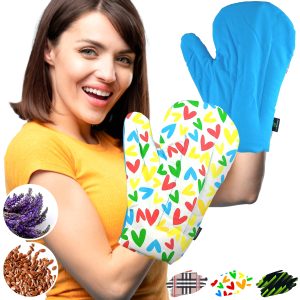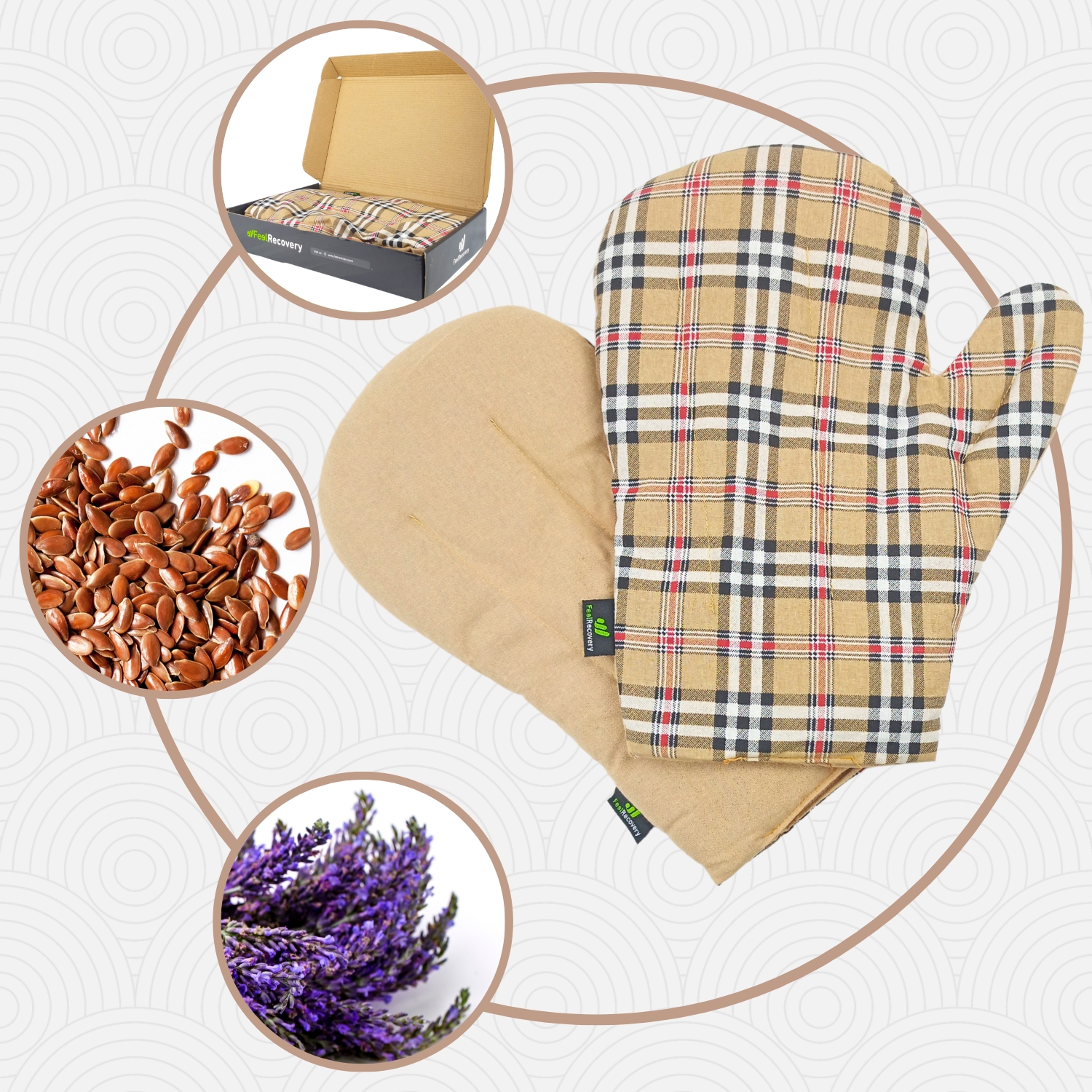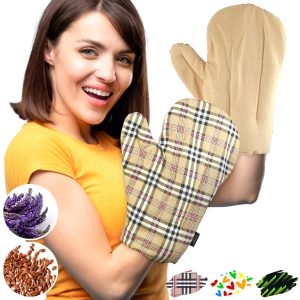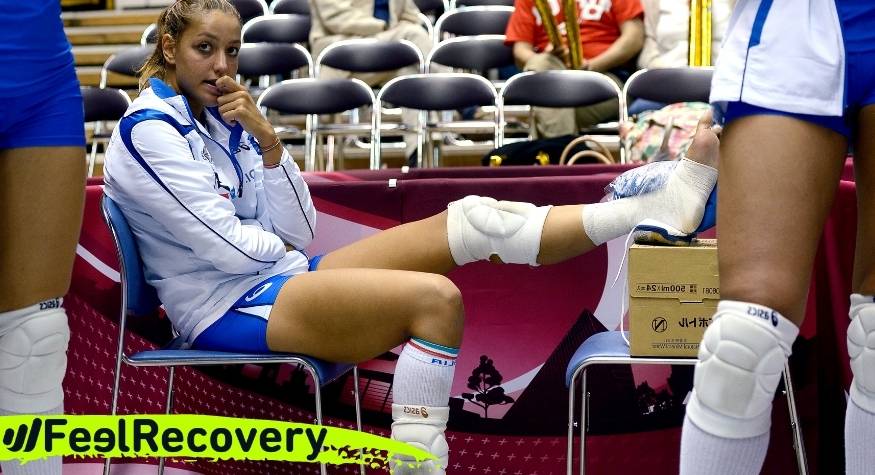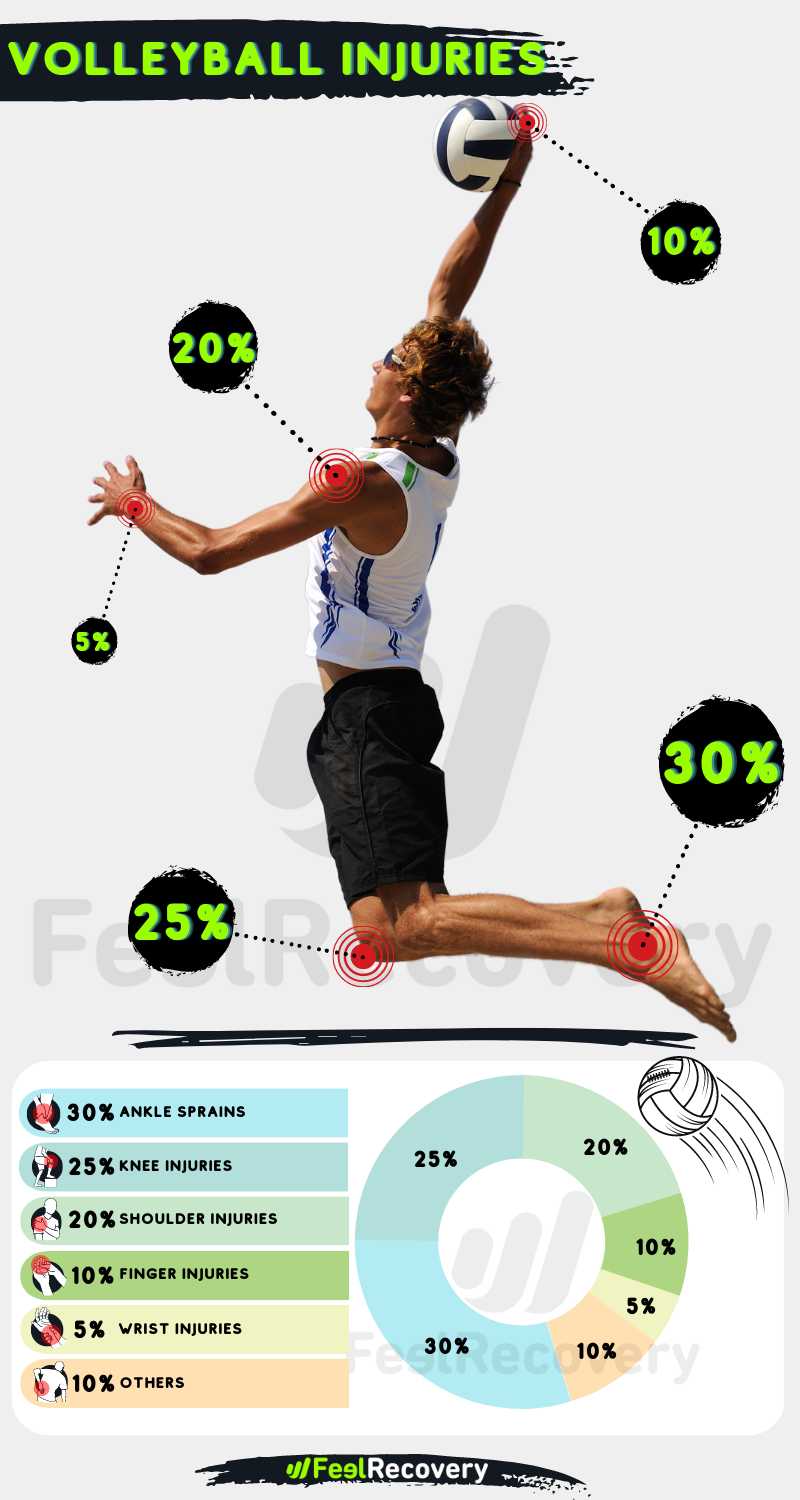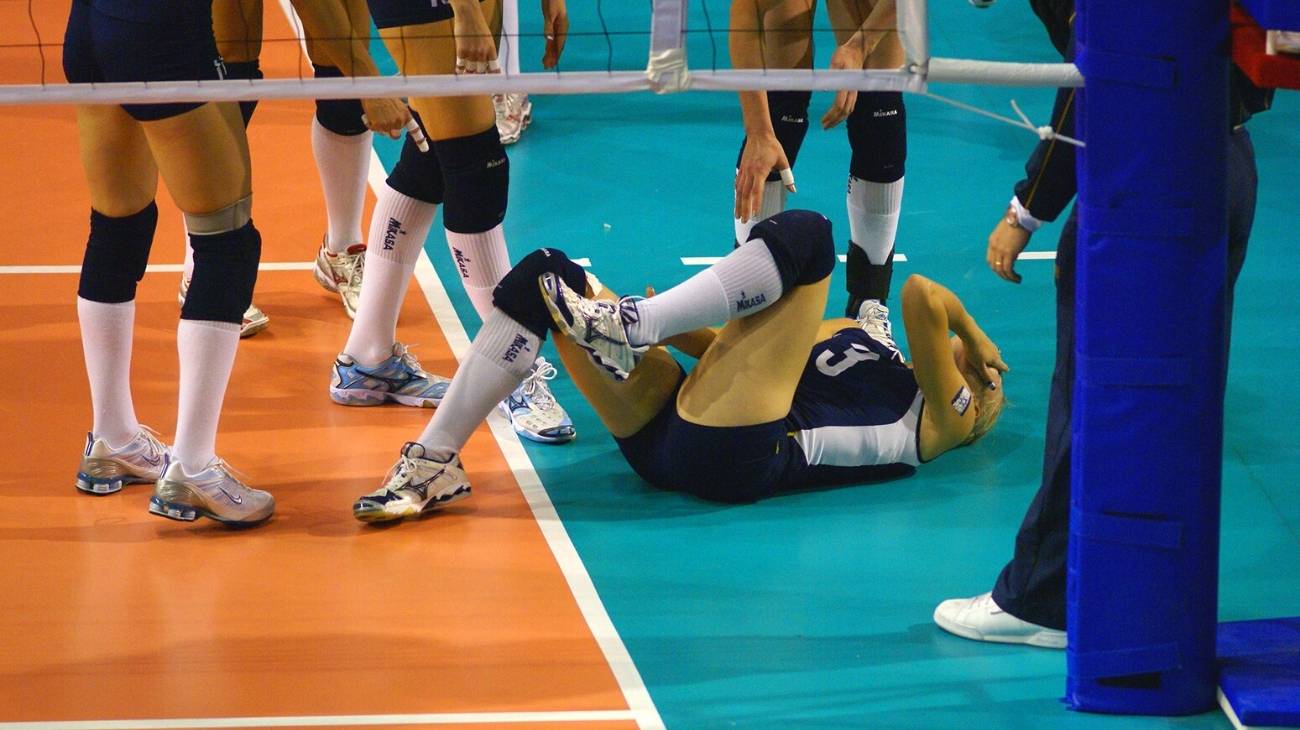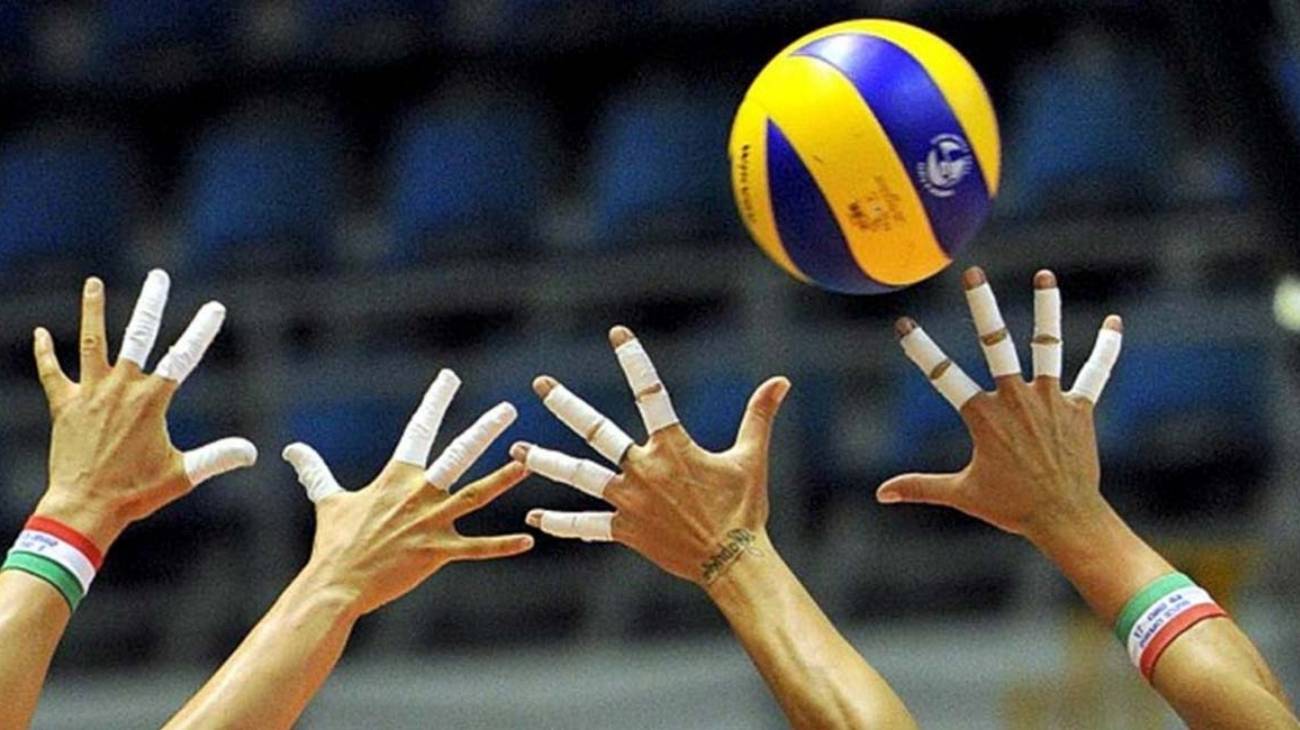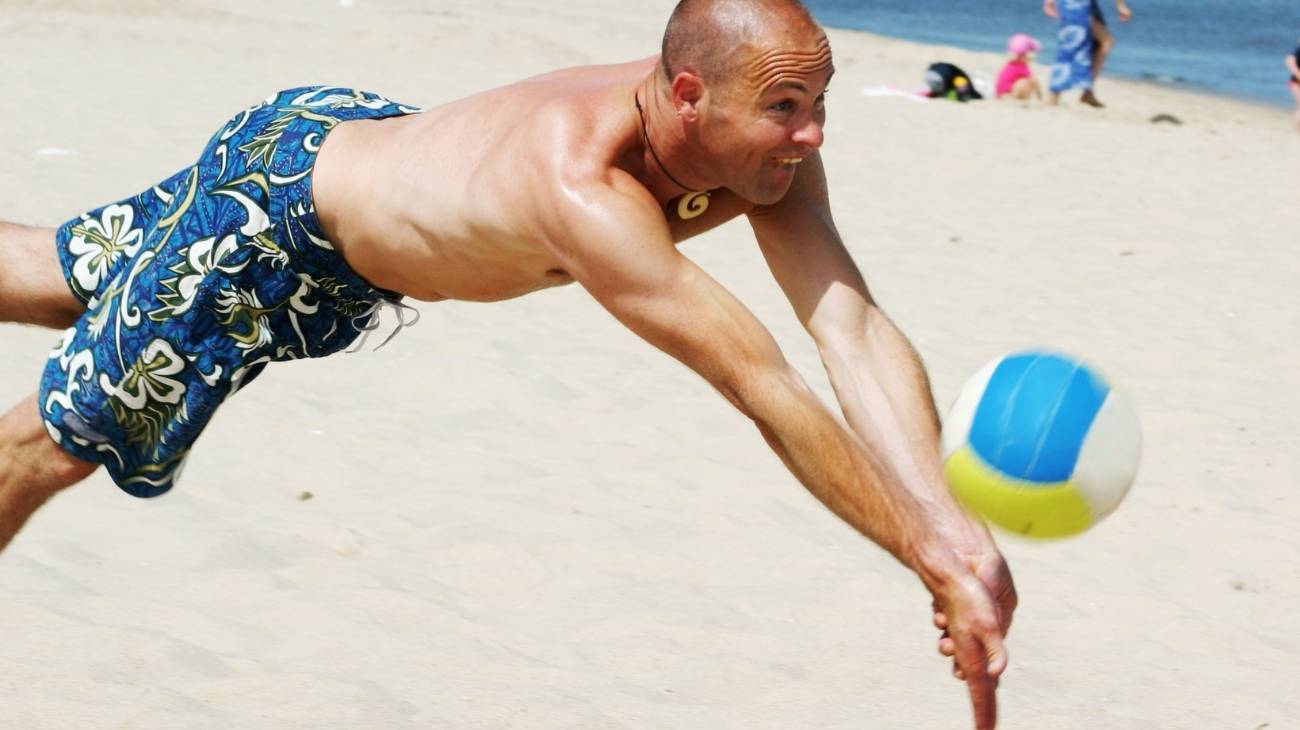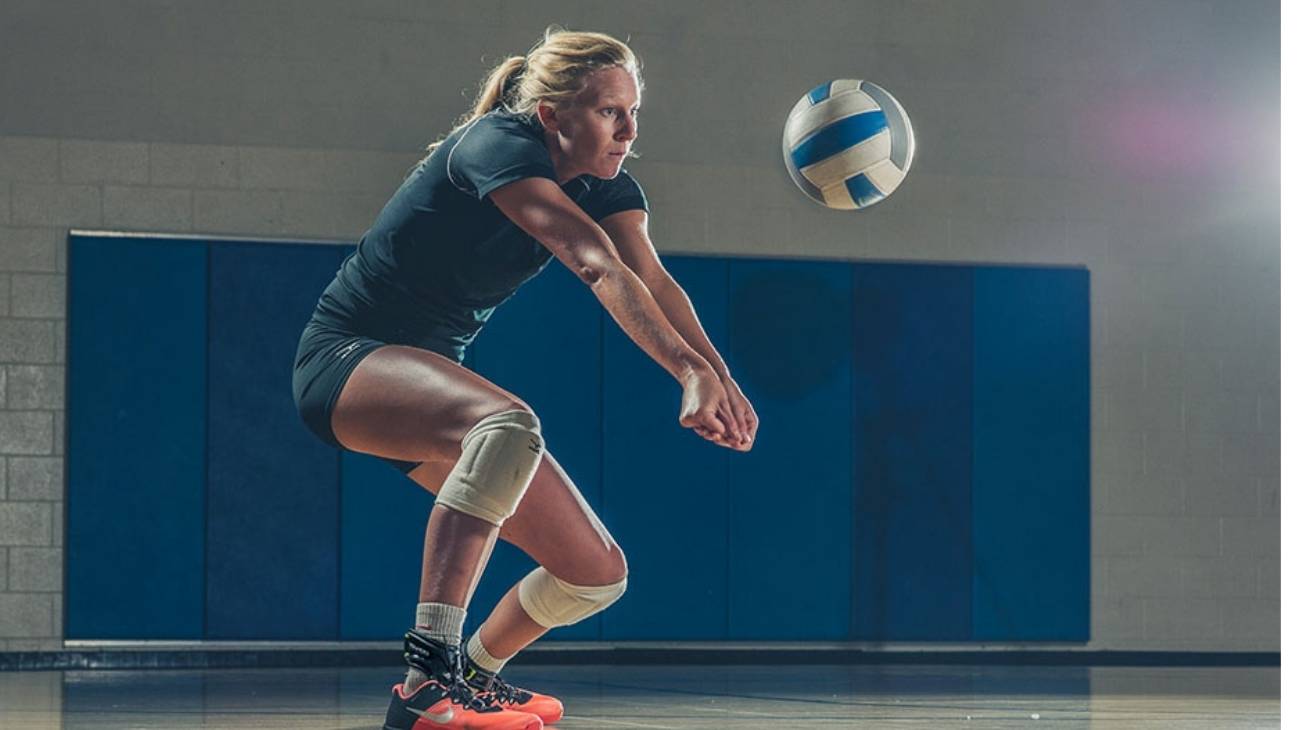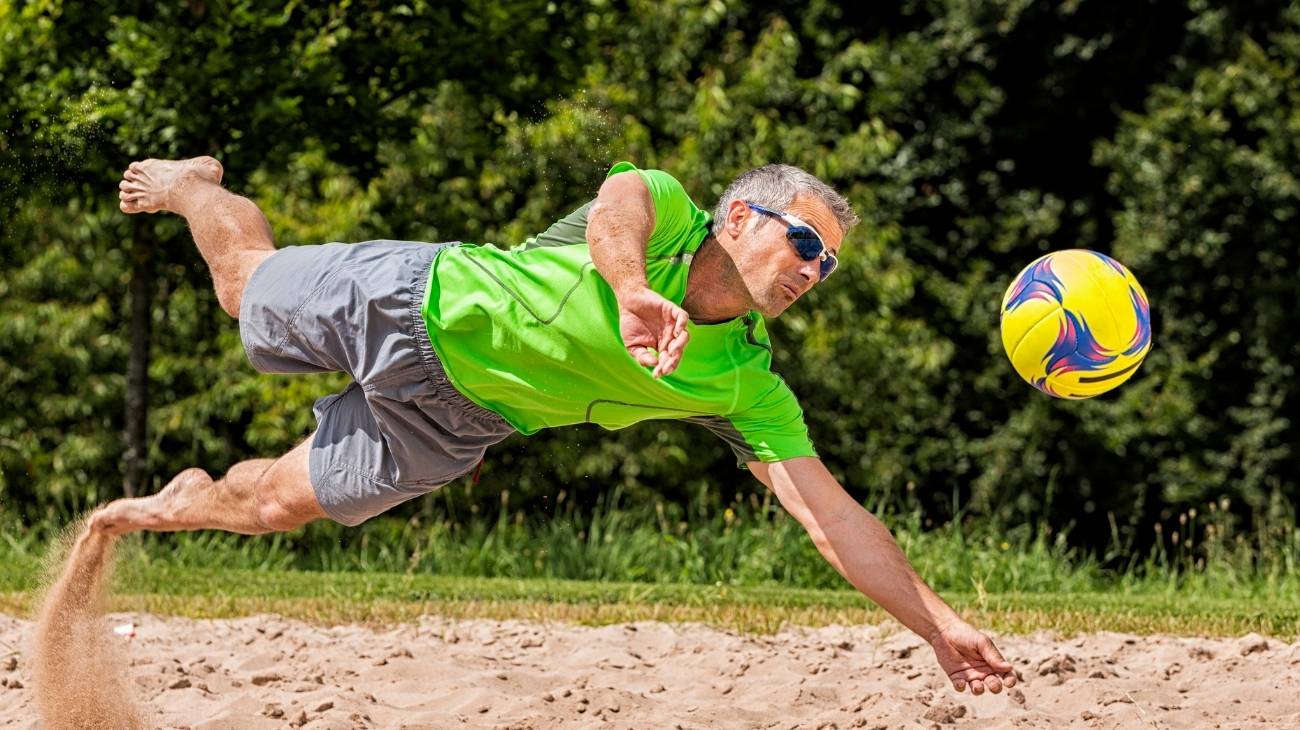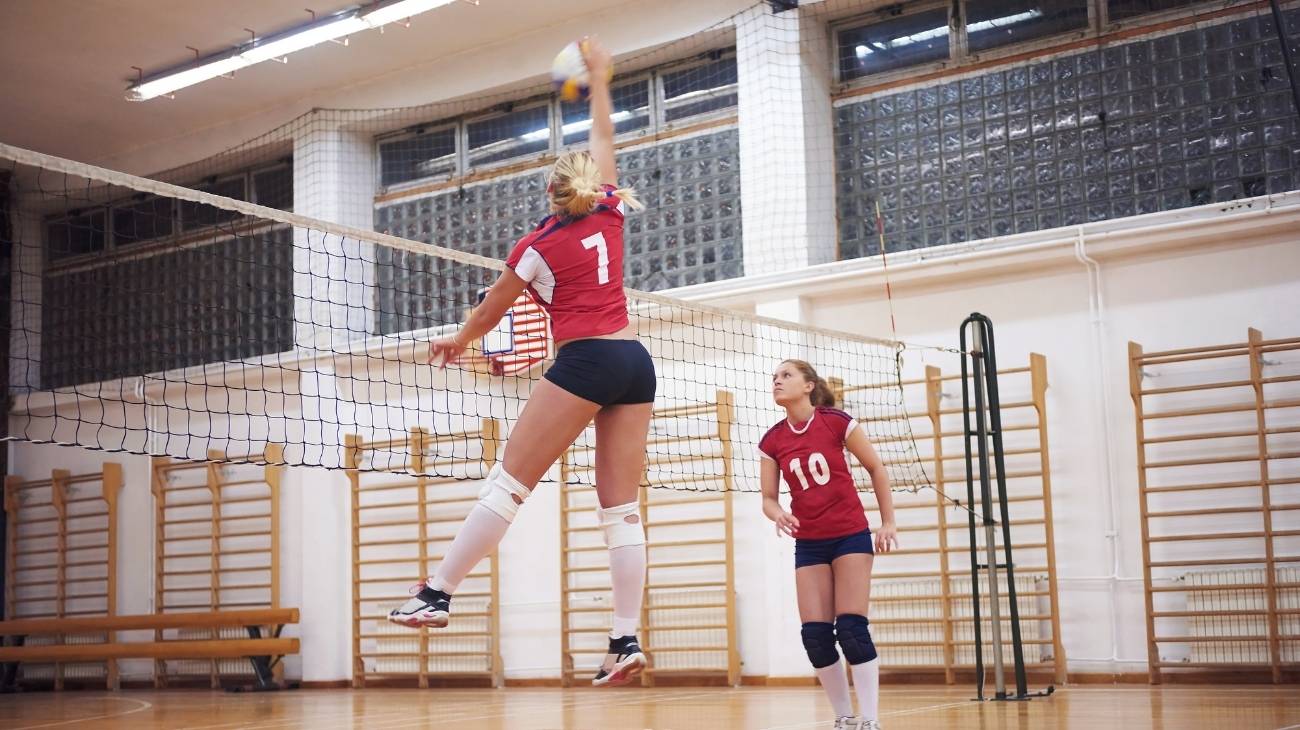Volleyball is one of the most popular sports available today. Unfortunately, sports injuries often arise when playing volleyball, whether during a training session or match. Knowing each of these common conditions and how to prevent them is vital.
In this sense, we have prepared this post to tell you what are the most common sports injuries in volleyball and some tips to prevent them. Here we go!
What are the most common types of injuries when playing volleyball?
There are a number of common volleyball injuries that we could mention. In fact, volleyball players are prone to shoulder, knee, ankle, finger, head and lower back injuries. Some of these are due to overuse but others are caused by trauma.
The most common injuries in volleyball are:
Shoulder injuries
Volleyball involves repeated and strenuous overhead movements. These include: spiking, serving (overhead), blocking, setting and passing. Continuous overhead movements often lead to overuse shoulder pathologies in volleyball such as:
- Rotator cuff tendinitis: This overuse condition consists of inflammation or irritation of the rotator cuff tendons. Basically the symptoms are: local inflammation and pain in the shoulder that worsens with movements such as pushing, pulling and raising the arm.
- Shoulder impingement: Occurs when the acromion rubs or pinches the rotator cuff. It causes pain in the shoulder that may worsen with movement, especially when raising the arm overhead. It is often associated with rotator cuff tendinitis and subacromial bursitis.
- SLAP lesions: These involve a tear in the upper part of the labrum. There are several types, the most common involving separation of the upper labrum and biceps tendon from the glenoid cavity. They generally cause shoulder pain (with overhead movement), weakness, crepitus and mobility problems.
Hand and finger injuries
Arise due to trauma involving contact with the ball (especially during blocking), the net, the ground or other players. These injuries most often affect the fingers, although they can also occur in the rest of the hand. They must be treated early and properly to avoid long-term joint stiffness and deformity.
These hand and wrist injuries include the following:
- Sprains: These are the overstretching or tearing (partial or total) of a ligament in the hand. They most commonly occur in the interphalangeal and metacarpophalangeal joints of the fingers. It may be caused by a fall or blow. The usual symptoms are pain, swelling and bruising.
- Fractures: A fracture is the breaking of a bone in the hand. It is a traumatic injury that can be caused by a blow or crushing. It causes deformity, pain, tenderness, swelling, bruising, motor difficulties and numbness.
- Finger dislocations and subluxations: These occur when one of the finger bones slips out of place. They are most common in the middle joints. They are usually caused by a blow or force that bends the toe backwards or in other directions forcibly. Common symptoms are deformity, pain, swelling and limited mobility.
Back injuries
Volleyball players also frequently present with pain in the lumbar region. This is associated with the rotational, flexion and/or extension movements involved in the sport that involve the lower back. In most cases this pain corresponds to:
- Lumbar strain: It lies in the partial or total tearing of the muscles and tendons of the lumbar region. It is caused by very forced movements of this area, such as sudden twisting. It causes sudden low back pain that worsens with movement, spasm, tenderness and swelling.
- Lumbar sprain: This is the overextension or rupture (partial or total) of the ligaments belonging to the lower back. It is caused by a fall, accident, blow or bad movement. It causes lower back pain that can extend to the buttocks and thighs. It also causes mobility problems.
Knee injuries
Among the most common types of injuries in volleyball are certain knee injuries. They occur due to the repetitive jumps, knee collisions (against the ground or other players) and sudden turns that occur in this sport.
From this group of injuries we can highlight:
- Anterior cruciate ligament (ACL) sprain: Occurs when the ACL is overstretched or torn (partially or completely). It is of traumatic aetiology and generally arises when changing direction suddenly, decelerating suddenly, landing from a jump incorrectly or due to a blow. It causes the following symptoms: pain, swelling, difficulty of movement and a feeling of instability.
- Patellar tendonitis (jumper's knee): This occurs when the patellar tendon suffers small tears. It is mainly caused by overuse of the knee. It causes pain, stiffness and discomfort in this joint.
Ankle and foot injuries
Volleyball players are also prone to these injuries, most notably ankle sprains. Continuous jumping, shifting and rotation involving the feet are the main risk factors in this category.
The main injuries in this group include the following:
- Ankle sprains: These consist of unnatural stretching or tearing of the ankle ligaments. Often the external ligaments are affected (inversion ankle sprain). They are usually caused by forced supination when a player lands on another player's foot, which usually occurs during a block or spike at the net. Pain, tenderness, swelling, bruising, limited mobility, instability and crepitus are the main symptoms.
- Plantar fasciitis: This is inflammation of the plantar fascia. It is usually associated with overuse of the foot, although in many cases there is no direct cause. It is characterised by shooting pain at the heel.
- Achilles tendonitis: This is inflammation of the Achilles tendon. It is considered an overuse injury caused by intense or repetitive stress on the Achilles tendon. It causes pain in the back of the calf or heel, stiffness and swelling.
Best products for volleyball injury recovery
Bestseller
-
2 Ankle Compression Sleeve (Black/Gray)
$19.95 -
2 Ankle Compression Sleeve (Green/Navy)
$19.95 -
2 Ankle Compression Sleeve (Pink/Bordeaux)
$19.95 -
2 Calf Compression Sleeve (Black/Gray)
$19.95 -
2 Calf Compression Sleeve (Green/Navy)
$19.95 -
2 Calf Compression Sleeve (Pink/Bordeaux)
$19.95 -
2 Knee Compression Sleeve (Black/Gray)
$19.95 -
2 Knee Compression Sleeve (Green/Navy)
$19.95 -
2 Knee Compression Sleeve (Pink/Bordeaux)
$19.95 -
2 Patella Knee Strap (Black/Gray)
$14.95 -
2 Patella Knee Strap (Green/Navy)
$14.95 -
2 Patella Knee Strap (Pink/Bordeaux)
$14.95 -
2 Thigh Compression Sleeve (Black/Gray)
$19.95 -
2 Thigh Compression Sleeve (Green/Navy)
$19.95 -
2 Thigh Compression Sleeve (Pink/Bordeaux)
$19.95 -
Acupressure Mat and Pillow (Black/Gray)
$49.95 -
Acupressure Mat and Pillow (Green/Navy)
$49.95 -
Acupressure Mat and Pillow (Pink/Bordeaux)
$49.95 -
Acupressure Pillow (Black/Gray)
$29.46 -
Acupressure Pillow (Green/Navy)
$29.46 -
Acupressure Pillow (Pink/Bordeaux)
$29.46 -
Foot Massage Roller for Plantar Fasciitis (Black)
$19.95 -
Foot Massage Roller for Plantar Fasciitis (Green)
$19.95 -
Foot Massage Roller for Plantar Fasciitis (Pink)
$19.95 -
High Density Foam Roller for Muscle (Black/Gray)
$29.95 -
High Density Foam Roller for Muscle (Green/Navy)
$29.95 -
High Density Foam Roller for Muscle (Pink/Bordeaux)
$29.95 -
Ice Massage Roller Ball (Black)
$39.95 -
Ice Massage Roller Ball (Green)
$39.95 -
Ice Massage Roller Ball (Pink)
$39.95 -
Microwave Arthritis Gloves (2 Mittens) (Hearts)
$29.95 -
Microwave Arthritis Gloves (2 Mittens) (Oxford)
$29.95 -
Microwaveable Heating Pad for Pain Relief (Hearts)
$19.95 -
Microwaveable Heating Pad for Pain Relief (Oxford)
$19.95 -
Microwaveable Heating Pad for Pain Relief (Sport)
$19.95 -
Pack 2 In 1 Foam Roller High + Soft Density (Black/Gray)
$29.95 -
Pack 2 In 1 Foam Roller High + Soft Density (Green/Navy)
$29.95 -
Pack 2 In 1 Foam Roller High + Soft Density (Pink/Bordeaux)
$29.95 -
Shoulder Support Brace (Black)
$24.95 -
Shoulder Support Brace (Green)
$24.95 -
Shoulder Support Brace (Pink)
$24.95 -
Soft Density Foam Roller for Recovery (Black)
$29.95 -
Soft Density Foam Roller for Recovery (Green)
$29.95 -
Soft Density Foam Roller for Recovery (Pink)
$29.95 -
Sport Compression Socks (1 Pair) (Black/Gray)
$19.95 -
Sport Compression Socks (1 Pair) (Green/Navy)
$19.95 -
Sport Compression Socks (1 Pair) (Pink/Bordeaux)
$19.95 -
Trigger Point Massage Stick (Black)
$14.95 -
Trigger Point Massage Stick (Green)
$14.95 -
Trigger Point Massage Stick (Pink)
$14.95 -
Wrist Brace (Black/Gray)
$19.95 -
Wrist Brace (Green/Navy)
$19.95 -
Wrist Brace (Pink/Bordeaux)
$19.95
How to prevent injuries when playing volleyball?
In this block we will teach you how to prevent sports injuries in volleyball through a series of tips. The truth is that many players get injured if they don't take these tips into account. If you do not want to suffer the same fate, it is essential that you pay attention to them.
To avoid injuries in volleyball we suggest you:
- Warm up well: It is vital to warm up for 15 to 25 minutes before a volleyball match or practice. This will prepare the body to perform the physical activity with a minimum risk of injury. The warm-up should include: cardio exercises (such as jogging), joint movements, muscle stretching, intensity exercises, as well as touches and passes with the ball.
- Finish training with a cool down: It is essential to cool down after a volleyball game or practice for approximately 20 minutes. This should include muscle stretching exercises, gentle physical activity (such as walking) and deep breathing. This helps restore heart rate, temperature and respiration to their resting states. It also promotes the onset of tissue recovery and the elimination of toxic substances.
- Good nutrition and hydration: It is very important that volleyball players hydrate and nourish themselves properly. Before training or competition it is advisable to consume a dish rich in carbohydrates, moderate in protein and low in fat. Between matches on the same day it is vital to hydrate and consume foods such as energy bars or dried fruit. Finally, within 1 hour after the end of the sporting activity you should eat food with a significant carbohydrate and lean protein load.
- Improve your physical condition: Being in good physical condition is vital in the prevention of sports injuries in volleyball. Therefore, those who play the sport must do the right training to stay in shape. All in order to achieve optimal strength, speed, endurance, coordination and flexibility.
- Sports massage: Through sports massage the athlete's body is prepared for the subsequent efforts in volleyball. In addition, injuries are prevented and the recovery of injured tissues is promoted. These massages take place before, during or after training or competition.
- Use of hot/cold therapies: Contrast therapy (alternating application of cold and heat) is of great help in the treatment of sports injuries in volleyball. On the one hand, heat has a vasodilator effect that promotes circulation and relaxation. On the other hand, cold acts as a powerful anti-inflammatory and analgesic.
- Use of compression garments: Compression garments (shorts, shirts, sleeves, among others) apply a beneficial pressure on the body. They increase circulation, which promotes inflammation and tissue recovery. They also help to reduce muscle fatigue and vibration as well as the risk of injury. They also provide greater body awareness (proprioception) and maintain an optimal temperature.
- Use of acupressure therapies: Acupressure is a technique of Chinese origin in which pressure is applied to specific points on the body with the hands. As a result, pain and muscle tension are relieved. Thus, this therapy is ideal for preventing and treating sports injuries in volleyball players.
- Use of thermotherapy and cryotherapy: Both methodologies are indicated in the treatment and prevention of injuries. On the one hand, thermotherapy promotes circulation, accelerating recovery and relaxing muscles. On the other hand, cryotherapy has the ability to reduce inflammation and pain.
- Using the right equipment: Having the right equipment is fundamental in the prevention of volleyball injuries. On the one hand, you should choose the right clothing and footwear so that it is comfortable and safe. It is also important to have a volleyball in good condition. In addition, it is advisable to use knee, elbow and ankle braces.
How to apply the RICE therapy to treat first aid injuries in volleyball players?
The RICE therapy protocol consists of a series of steps from which it derives its name. These steps are: rest, ice, compression and elevation. It is applied in the treatment of injuries especially in the early stage before seeking help at a medical centre. There is a similar method called PRICE, which is actually an update of the RICE therapy with a new step: protection. Although it must be said that RICE is better known.
Here are the steps of the PRICE therapy:
- Protection: This basically consists of protecting the affected area. In this sense, sporting activity is forbidden, as are harmful movements. In fact, the use of immobilisers such as slings, ankle braces, among others, is recommended.
- Rest: Adequate rest of the affected area should be provided for a period of approximately 48 hours. It should be noted that non-injurious movements are recommended to avoid stiffness.
- Ice: The application of ice is very beneficial in case of injury, as it helps to reduce pain and inflammation. At this point you should cool a compress to 10 or 20 °C and place it on the injury for 20 minutes. This can be done 6 to 8 times a day.
- Compression: Properly compressing the affected area promotes blood circulation, which helps to reduce swelling. It also provides greater stiffness and stability. At this stage it is usual to bandage the wound with a flexible fabric that provides some mobility. The bandage should not be applied too tightly or circulation may be cut off.
- Elevation: Elevating the injured area helps to reduce swelling and pain significantly. At this stage the affected area should be placed on a cushioned surface so that it remains at a level above the heart.
References
- Eerkes, K. (2012). Volleyball injuries. Current sports medicine reports, 11(5), 251-256. https://journals.lww.com/acsm-csmr/Fulltext/2012/09000/Volleyball_Injuries.10.aspx
- Verhagen, E. A. L. M., Van der Beek, A. J., Bouter, L. M., Bahr, R. M., & Van Mechelen, W. (2004). A one season prospective cohort study of volleyball injuries. British journal of sports medicine, 38(4), 477-481. https://bjsm.bmj.com/content/38/4/477.short
- Bahr, R., & Reeser, J. C. (2003). Injuries among world-class professional beach volleyball players: the Federation Internationale de Volleyball beach volleyball injury study. The American journal of sports medicine, 31(1), 119-125. https://journals.sagepub.com/doi/abs/10.1177/03635465030310010401
- Bahr, R., & Bahr, I. A. (1997). Incidence of acute volleyball injuries: a prospective cohort study of injury mechanisms and risk factors. Scandinavian journal of medicine & science in sports, 7(3), 166-171. https://onlinelibrary.wiley.com/doi/abs/10.1111/j.1600-0838.1997.tb00134.x
- Agel, J., Palmieri-Smith, R. M., Dick, R., Wojtys, E. M., & Marshall, S. W. (2007). Descriptive epidemiology of collegiate women's volleyball injuries: National Collegiate Athletic Association Injury Surveillance System, 1988–1989 through 2003–2004. Journal of athletic training, 42(2), 295-302. https://cdr.lib.unc.edu/concern/articles/4b29bc963
- Briner Jr, W. W., & Benjamin, H. J. (1999). Volleyball injuries: managing acute and overuse disorders. The Physician and sportsmedicine, 27(3), 48-60. https://www.tandfonline.com/doi/abs/10.3810/psm.1999.03.720
- Reeser, J. C., & Bahr, R. (2011). Principles of prevention and treatment of common volleyball injuries. WEB-ресурс Fédération Internationale de Volleyball (FIVB). URL: http://www. fivb. org/en/medical/document/fivb_medical_injury_prevention. pdf(дата обращения 3.04. 2015). https://www.volleyballalberta.ca/sites/default/files/sites/Leadership/Coaches/Resources/Injury_Prevention-FIVB.pdf
- Schafle, M. D. (1993). Common injuries in volleyball: treatment, prevention and rehabilitation. Sports Medicine, 16(2), 126-129. https://link.springer.com/article/10.2165/00007256-199316020-00004
- Reeser, J. C., & Bahr, R. (Eds.). (2017). Handbook of sports medicine and science, Volleyball. John Wiley & Sons. https://books.google.es/books?hl=en&lr=&id=ehqACgAAQBAJ
- Reeser, J. C., Verhagen, E. A. L. M., Briner, W. W., Askeland, T. I., & Bahr, R. (2006). Strategies for the prevention of volleyball related injuries. British journal of sports medicine, 40(7), 594-600. https://bjsm.bmj.com/content/40/7/594.short













































